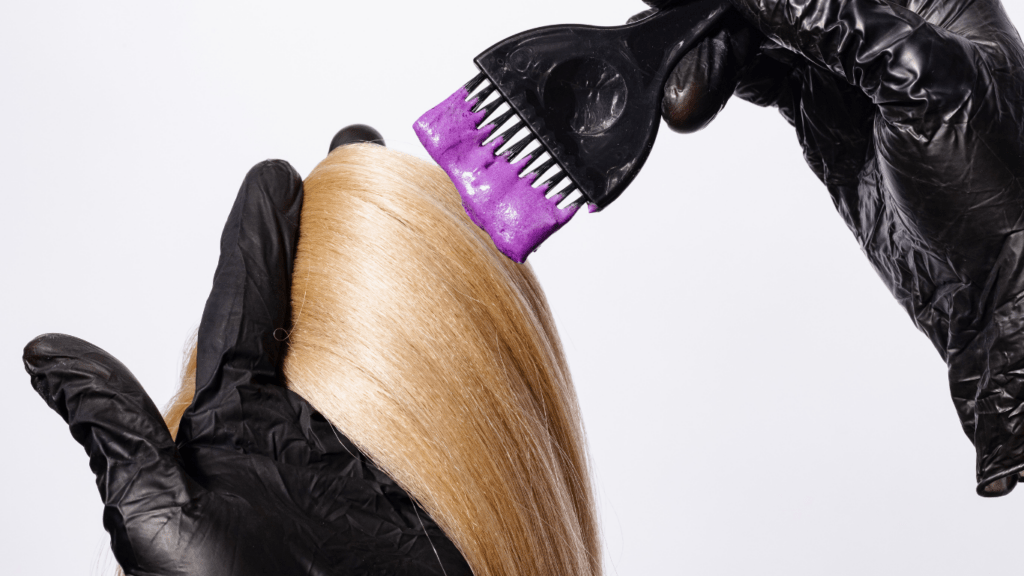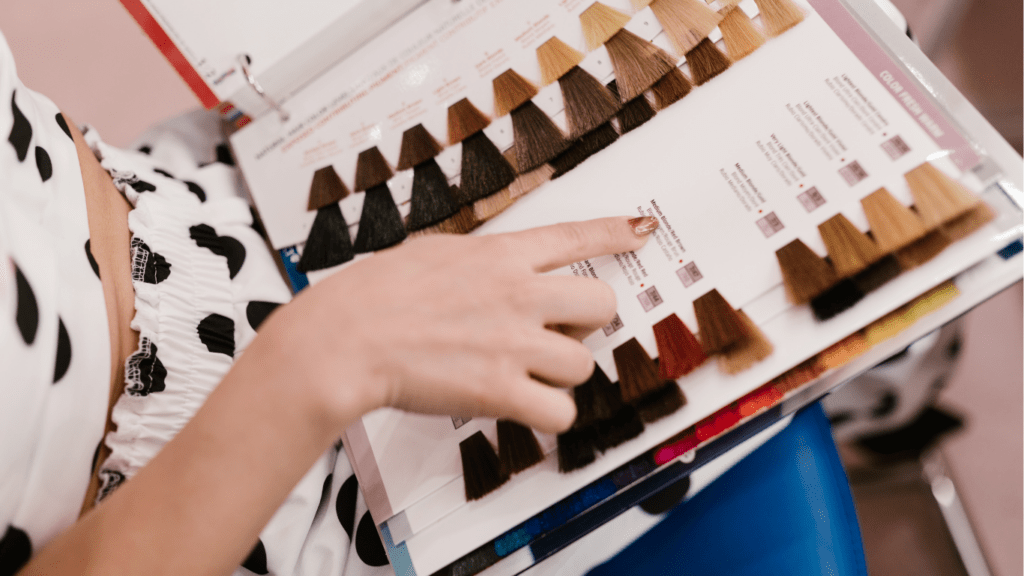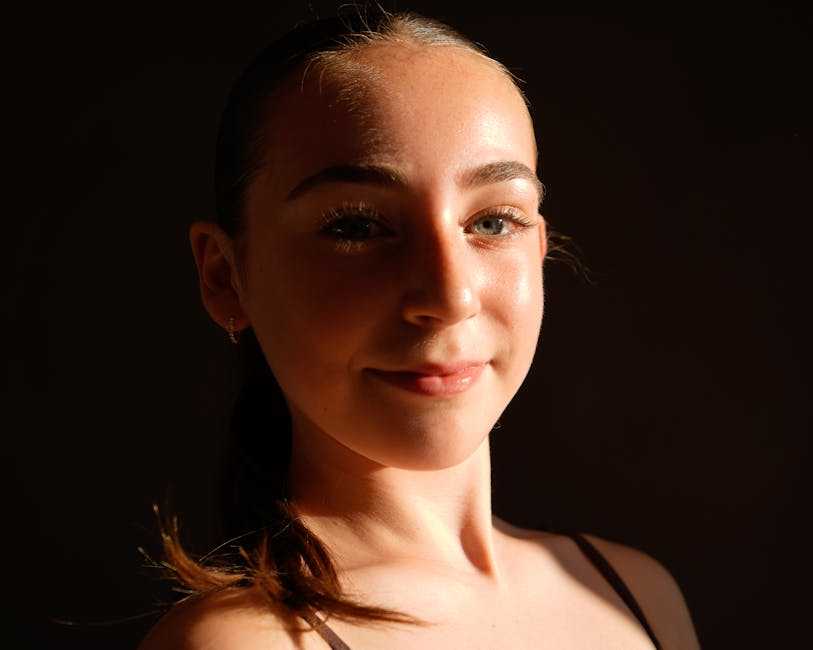The Basics of Hair Coloring
Knowing the basics of hair coloring helps you make informed decisions. Let’s explore the history and types of hair dye.
History of Hair Coloring
Hair coloring dates back to ancient Egypt. People used henna and other natural dyes to alter and enhance their hair color. Romans preferred plant-based dyes and experimented with different techniques.
By the 1800s, synthetic dyes emerged, revolutionizing the industry. French chemist Eugène Schueller developed the first synthetic hair dye in 1907, founding L’Oréal.
- Temporary Dye: This washes out after 1-2 shampoos. It’s ideal for special occasions. Products include color rinses and sprays.
- Semi-Permanent Dye: Lasting around 8-10 washes, it doesn’t penetrate the hair shaft deeply. It’s perfect for trying out new shades. Examples are conditioning color masks and gels.
- Demi-Permanent Dye: Lasting about 20-28 shampoos, it involves a gentle developer. It’s suitable for color enhancement and blending grays. Products include glosses and toners.
- Permanent Dye: Providing long-lasting color, it penetrates deeply. It’s best for dramatic changes and gray coverage. Examples are traditional box dyes and professional salon treatments.
Preparing for Hair Coloring

Knowing what to expect before coloring helps ensure great results. Several steps can significantly improve the outcome and health of your hair.
Choosing the Right Color
Selecting the right hair color is crucial. First, I recommend considering your natural hair color and skin tone. Warmer skin tones often complement rich, warm shades like caramel or auburn. Cooler skin tones usually pair well with ashy or cool shades, such as platinum blonde or cool brown. Consulting a professional stylist can provide personalized advice based on your unique characteristics.
Allergy Patch Tests
Conducting an allergy patch test is essential to avoid adverse reactions. I suggest applying a small amount of the dye to a discrete skin area, like behind the ear or on the inner elbow. Leave it on for 24-48 hours without washing the area. If no redness or itching occurs, the product is likely safe to use. This step doesn’t just protect your skin, it ensures peace of mind for the coloring process.
The Hair Coloring Process
The hair coloring process involves several stages crucial for achieving the desired color while maintaining hair health. Understanding these steps helps in getting optimal results and a more pleasant experience.
Steps Involved in Coloring Hair
- Consultation: An initial meeting with a stylist helps determine the best color based on skin tone, natural hair color, and hair condition. This step includes discussing previous treatments and desired outcomes.
- Allergy Patch Test: This test detects any allergic reactions to the dye, and it’s performed 48 hours before the actual coloring.
- Preparation: Hair is washed and dried if necessary. Any needed treatments to balance hair porosity are applied to ensure even color absorption.
- Application: The color product is meticulously applied, starting from the roots and working towards the tips. The application method varies depending on the technique and desired effect.
- Processing Time: The dye sits on the hair for a specified period, typically between 20 to 45 minutes. This allows the color to penetrate the hair cuticles.
- Rinsing and Conditioning: After processing, hair is thoroughly rinsed to remove all traces of the dye. A deep conditioner is then applied to restore moisture and seal the color.
- Final Touches: Hair is styled as desired, and any necessary touch-ups or additional treatments are performed.
- Balayage: A freehand technique where color is painted onto sections of hair, creating a natural, sun-kissed look. It’s popular for its low-maintenance and natural results.
- Foiling: Hair is sectioned and wrapped in foil after applying color. This method allows for precise placement and is ideal for highlights and lowlights.
- Ombre: This technique results in a gradient effect, with hair gradually transitioning from a darker shade at the roots to a lighter shade at the ends.
- Single Process Hair Color: A single color is applied to the entire head, offering a uniform and consistent shade. This is common for permanent color applications.
- Double Process Hair Color: This involves two steps, usually lightening the hair first and then applying the desired color. It’s used for dramatic color changes, like going from dark to platinum blonde.
Understanding these methods and steps ensures better results and a healthier hair coloring experience.
Aftercare and Maintenance
Proper aftercare ensures vibrant and healthy hair post-coloring. Regular maintenance extends the life of the color and keeps hair looking its best.
Tips for Maintaining Color
Avoid Heat Styling Excessively
Heat styling tools (flat irons, curling irons) fade color quickly. Use these tools sparingly to preserve vibrancy.
Limit Sun Exposure
UV rays damage hair and speed up fading. Wear a hat or use UV-protection spray when outdoors.
Rinse with Cool Water
Hot water opens hair cuticles, causing color to wash out faster. Use cool water to rinse and lock in color.
Wash Hair Less Frequently
Frequent washing strips away natural oils and color molecules. Try washing hair 2-3 times weekly using a color-safe shampoo.
Deep Condition Regularly
Color-treated hair tends to be drier. Use deep conditioning treatments weekly to keep hair moisturized and shiny.
Products to Use and Avoid
Use Sulfate-Free Shampoos
Sulfates strip natural oils and fade color. Opt for sulfate-free shampoos to maintain color longer.
Choose Color-Safe Conditioners
Color-safe conditioners contain ingredients that protect and nourish treated hair, enhancing longevity and vibrancy.
Use Leave-In Treatments
Leave-in treatments add moisture and protection against heat and environmental damage. Look for ones designed for color-treated hair.
Avoid High-Alcohol Content Styling Products
Products with high alcohol content dry out hair and strip color. Check ingredient lists and avoid these products.
Avoid Clarifying Shampoos
Clarifying shampoos remove buildup but are too harsh for color-treated hair. They strip color quickly, so use them sparingly if at all.
These aftercare tips and product recommendations help maintain hair color and health, keeping your locks looking fresh and vibrant long after the initial coloring process.



 Product Review Expert
Marta is the product guru of the team, with a keen eye for discovering the best hair care products available. She meticulously tests and reviews shampoos, conditioners, styling tools, and treatments to give readers honest, in-depth insights. Marta’s expertise ensures that only the highest quality products are recommended, making her reviews an essential guide for anyone looking to invest in their hair care routine.
Product Review Expert
Marta is the product guru of the team, with a keen eye for discovering the best hair care products available. She meticulously tests and reviews shampoos, conditioners, styling tools, and treatments to give readers honest, in-depth insights. Marta’s expertise ensures that only the highest quality products are recommended, making her reviews an essential guide for anyone looking to invest in their hair care routine.
